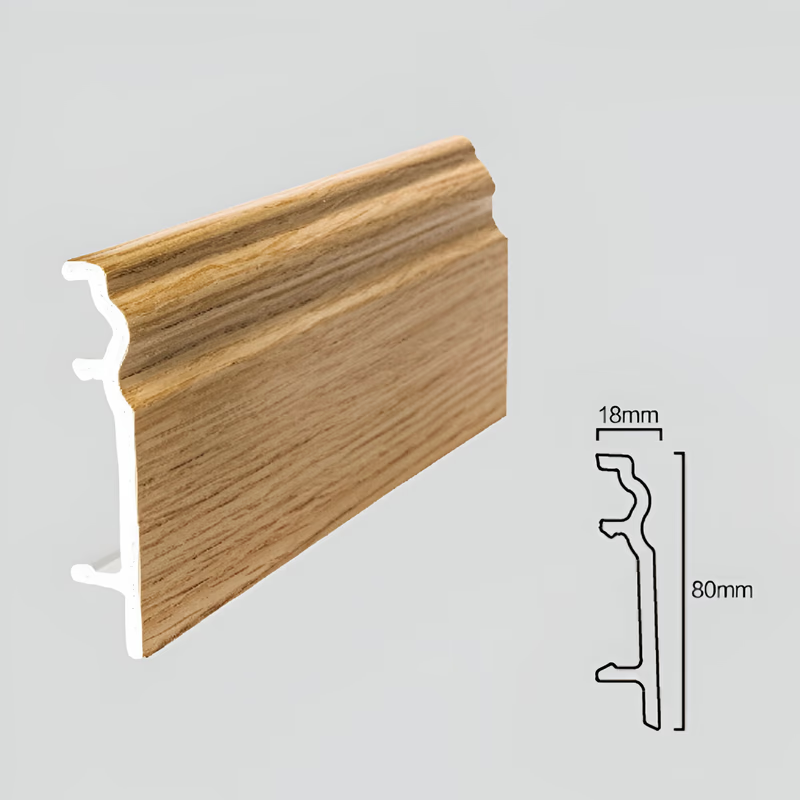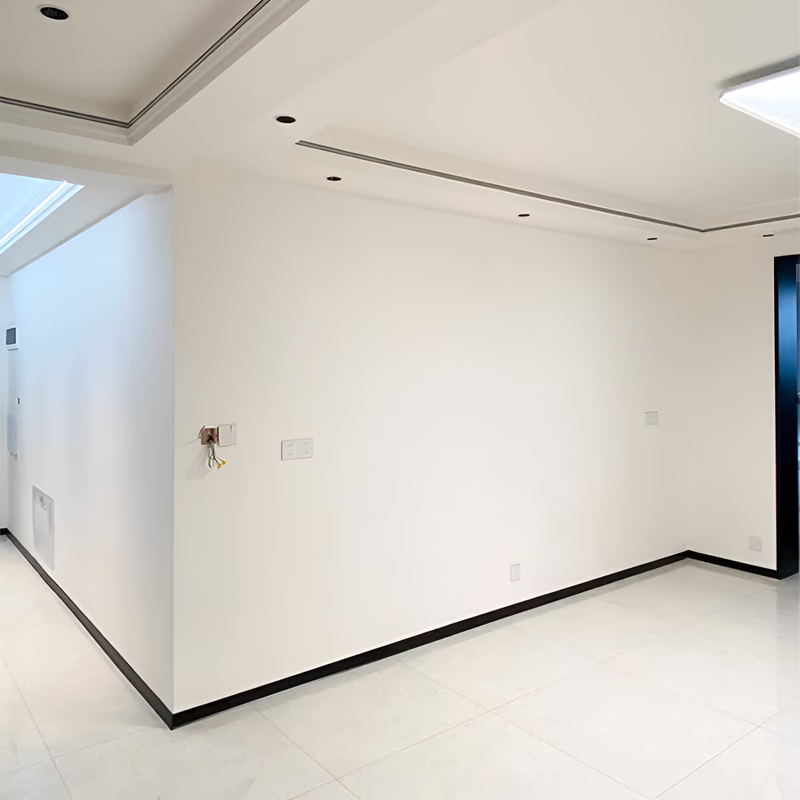Looking for the best baseboard material for your home? Tired of dealing with warped, rotted skirting boards? In fact, more and more homeowners have turned to aluminum skirting boards. Let’s compare the essential differences between aluminum, MDF, and wood skirting boards to tell you which one is best for you.
What is an Aluminum Baseboard
Ever wondered why modern homes are switching to aluminum baseboards? Aluminum baseboards bring fresh solutions to old problems. These metal pieces keep your walls safe and make rooms look better.
Had enough of wet, rotting baseboards? Aluminum doesn't rust or grow mold. You can say goodbye to yearly painting and patching.
Types of Aluminum Baseboards





Each type works best in different places. They're all tough, easy to clean, and keep looking good. Which matches what you need?
What is a MDF Baseboard
Wondering about those smooth, affordable baseboards in new homes? MDF baseboards mix recycled wood fibers with resin under high pressure. Unlike wood, they arrive smooth and ready for paint, saving you time and money.
Does your home need new baseboards that won't break your budget? MDF costs about 10% less than wood, while still giving your walls that clean, finished look. Plus, you won't find any knots or grain patterns to work around.

Types of MDF Baseboards
Each style handles daily bumps and scuffs well when properly painted. Just keep them away from water, and they'll keep your walls looking sharp for years.
>> See Types of Skirting Board: 13 Popular Profiles in 2024
What is a Wood Baseboard
Why do homeowners still pick wood baseboards and trim? Real wood shows off natural patterns in every piece. When you touch it, you feel actual wood grain, not a printed copy.
Should you spend more on wood baseboards and moldings? They last longer than cheaper options. Wood doesn't crack like plastic or dent like MDF when your vacuum hits it.

Types of Wood Baseboards
Aluminum Baseboard vs MDF vs Wood: Differences
Now that we've looked at each type of baseboard, let's help you pick the perfect match for your space. Each material brings unique benefits that work best in different situations.
Aluminum Pros
Aluminum Cons
MDF Pros
MDF Cons
Wood Pros
Wood Cons




What Should You Buy?
After comparing aluminum, MDF, and wood baseboards, which one matches your needs? Let's break down the best choices for different situations.
For bathrooms, kitchens, and wet areas, aluminum baseboards make the most sense. They never rot, warp, or swell when exposed to water. Plus, they come with modern features like built-in LED lighting that can transform your space.
For dry living areas on a budget, MDF baseboards work well. They cost between $1.00-1.40 per foot and take paint beautifully. Just keep them away from water and high-traffic spots where they might get damaged.
For traditional homes or areas that take heavy wear, wood baseboards remain a solid choice. Though they cost more ($0.85-7.00 per foot depending on wood type), they handle impacts well and can be refinished when worn.
Here's a quick guide for specific situations:
Look at the whole picture. Aluminum costs more now but saves on fixes later. MDF keeps costs down today but needs replacing sooner. Wood looks great but asks for regular upkeep.
Consider your installation preferences:
For most modern homes, aluminum baseboards offer the best value. They solve common baseboard problems like water damage, denting, and frequent maintenance. Plus, their clean lines and LED options let you create that contemporary look many homeowners want.
Remember, quality baseboards do more than just protect your walls. They add value to your space and save you from future headaches. Choose the material that matches both your immediate needs and long-term goals.
FAQs about Aluminum Baseboard vs MDF vs Wood
What is the expected lifespan of aluminum baseboards compared to wood and MDF?
Under residential conditions, aluminum baseboards last 20-30 years with zero degradation. Their marine-grade aluminum alloy (6063-T5) resists corrosion and impact damage. Wood baseboards typically need replacement after 7-10 years due to moisture damage, while MDF lasts 5-8 years before showing signs of deterioration. In high-traffic commercial spaces, aluminum still maintains 15-25 years of pristine appearance.
How does the long-term cost of aluminum baseboards compare to traditional materials?
A 100-foot aluminum baseboard installation costs $350-500 initially, versus $250-300 for wood and $150-200 for MDF. However, wood requires repainting every 3-4 years ($100-150 each time) and potential replacement after 10 years. MDF needs replacement every 5-7 years. Over a 20-year period, aluminum proves 40% more economical.
Pro tip: Factor in property value increase - aluminum baseboards add to modern home appeal during resale.
What skill level is required for aluminum baseboard installation?
A DIY weekend project requires:
- Basic tools: miter saw, level, measuring tape
- 2-3 hours for a 12x12 room
- Simple snap-on installation system
- No special carpentry skills
Pro tip: Start in less visible areas like closets to perfect your cutting technique. Order 10% extra material for corners and potential mistakes.
How do aluminum baseboards perform in high-moisture areas?
Aluminum baseboards feature a waterproof core and anodized surface that prevents rust, corrosion, and water damage. They maintain their shape in bathrooms, kitchens, and basements where humidity levels exceed 80%. The sealed design prevents water from seeping behind the baseboard, protecting wall integrity.
What customization options are available for aluminum baseboards?
Standard options include:
- Heights: 2.5", 3.5", 4.5", 5.5" (custom up to 7")
- Finishes: Brushed, matte, gloss, wood-grain
- Colors: 12 stock colors, custom matching available
- Surface treatments: Anti-fingerprint, scratch-resistant
- Corner pieces: Inside/outside premade corners
Pro tip: Request samples to test finishes under your actual lighting conditions.
What are the environmental benefits of aluminum baseboards?
Aluminum baseboards contain 60% recycled material and are 100% recyclable at end-of-life. Their production requires 45% less energy compared to virgin materials. Zero VOC emissions and no formaldehyde content make them safe for indoor air quality. A single installation eliminates the waste of multiple wood or MDF replacements.
What cable management features do aluminum baseboards offer?
Built-in cable channels accommodate up to three standard power cables or six network cables. Removable front panels provide easy access for cable changes. Specialized corner pieces maintain cable routing around turns. Optional internal dividers separate power from data cables for safety compliance.
How do aluminum baseboards prevent moisture and pest problems?
Protection features include:
- 2mm continuous floor-to-wall barrier
- Interlocking joints block pest entry
- Non-porous surface prevents mold growth
- EPDM rubber gasket seals uneven floors
- Thermal break prevents condensation
- Chemical-free pest prevention
Pro tip: Clean the floor-wall joint thoroughly before installation for optimal sealing.


